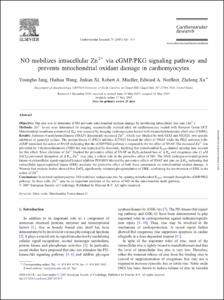KUMEL Repository
1. Journal Papers (연구논문)
1. School of Medicine (의과대학)
Dept. of Anesthesiology & Pain Medicine (마취통증의학)
NO mobilizes intracellular Zn2+ via cGMP/PKG signaling pathway and prevents mitochondrial oxidant damage in cardiomyocytes
- Keimyung Author(s)
- Jang, Young Ho
- Journal Title
- Cardiovascular Research
- Issued Date
- 2007
- Volume
- 75
- Issue
- 2
- Abstract
- Objective Our aim was to determine if NO prevents mitochondrial oxidant damage by mobilizing intracellular free zinc (Zn2+).
Methods Zn2+ levels were determined by imaging enzymatically isolated adult rat cardiomyocytes loaded with Newport Green DCF. Mitochondrial membrane potential (ΔΨm) was assessed by imaging cardiomyocytes loaded with tetramethylrhodamine ethyl ester (TMRE).
Results S-nitroso-N-acetylpenicillamine (SNAP) dramatically increased Zn2+, which was blocked by both ODQ and NS2028, two specific inhibitors of guanylyl cyclase. The protein kinase G (PKG) inhibitor KT5823 blocked the effect of SNAP while the PKG activator 8-Br-cGMP mimicked the action of SNAP, indicating that the cGMP/PKG pathway is responsible for the effect of SNAP. The increased Zn2+ was prevented by 5-hydroxydecanoate (5HD) but was mimicked by diazoxide, implying that mitochondrial KATP channel opening may account for this effect. Since chelation of Zn2+ blocked the preventive effect of SNAP on H2O2-induced loss of ΔΨm and exogenous zinc (1 μM ZnCl2) prevented dissipation of ΔΨm, Zn2+ may play a critical role in the protective effect of NO. The MEK (mitogen-activated protein kinase or extracellular signal-regulated kinase) inhibitor PD98059 blocked the preventive effects of SNAP and zinc on ΔΨm, indicating that extracellular signal-regulated kinase (ERK) mediates the protective effect of both these compounds on mitochondrial oxidant damage. A Western blot analysis further showed that ZnCl2 significantly enhances phosphorylation of ERK, confirming the involvement of ERK in the action of Zn2+.
Conclusions In isolated cardiomyocytes, NO mobilizes endogenous zinc by opening mitochondrial KATP channels through the cGMP/PKG pathway. In these cells, Zn2+ may be an important mediator of the action of NO on the mitochondrial death pathway.
KeywordsNitric oxide
Mitochondria
Protein kinase G
- Keimyung Author(s)(Kor)
- 장영호
- Publisher
- School of Medicine
- Citation
- Youngho Jang et al. (2007). NO mobilizes intracellular Zn2+ via cGMP/PKG signaling pathway and prevents mitochondrial oxidant damage in cardiomyocytes. Cardiovascular Research, 75(2), 426–433. doi: 10.1016/j.cardiores.2007.05.015
- Type
- Article
- ISSN
- 0008-6363
- Appears in Collections:
- 1. School of Medicine (의과대학) > Dept. of Anesthesiology & Pain Medicine (마취통증의학)
- 파일 목록
-
-
Download
 oak-aaa-00873.pdf
기타 데이터 / 647.79 kB / Adobe PDF
oak-aaa-00873.pdf
기타 데이터 / 647.79 kB / Adobe PDF
-
Items in Repository are protected by copyright, with all rights reserved, unless otherwise indicated.